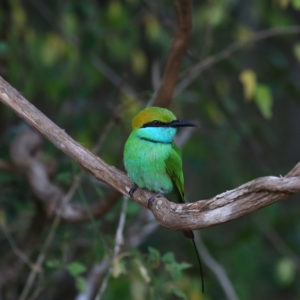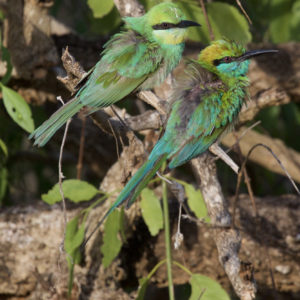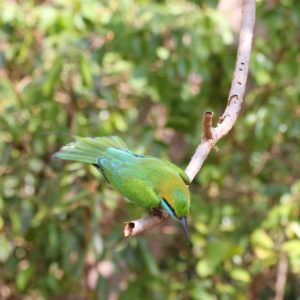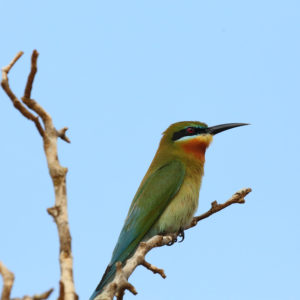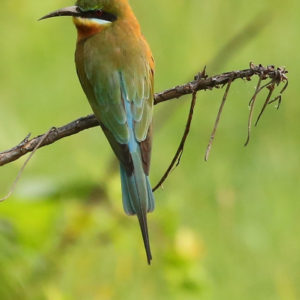Green Bee-Eater (Merops Orientalis)
The Green Bee-Eater (Merops Orientalis), also known as little green bee-eater, is a near passerine bird in the bee-eater family. It is resident but prone to seasonal movements and is found widely distributed across sub-Saharan Africa from Senegal and the Gambia to Ethiopia, the Nile valley, western Arabia and Asia through India to Vietnam. They are mainly insect eaters and they are found in grassland, thin scrub and forest often quite far from water. Several regional plumage variations are known and several subspecies have been named.
Chestnut-Headed Bee-Eater (Merops Leschenaulti)
The chestnut-headed bee-eater (Merops Leschenaulti), or bay-headed bee-eater, is a near passerine bird in the bee-eater family Meropidae. It is a resident breeder in the Indian subcontinent and adjoining regions, ranging from India east to Southeast Asia.
This species, like other bee-eaters, is a richly coloured, slender bird. It is predominantly green, with blue on the rump and lower belly. Its face and throat are yellow with a black eye stripe, and the crown and nape are rich chestnut. The thin curved bill is black. Sexes are alike, but young birds are duller.
This species is 18–20 cm long; it lacks the two elongated central tail feathers possessed by most of its relatives.
Blue-Tailed Bee-Eater (Merops Philippinus
The blue-tailed bee-eater (Merops philippinus) is a near passerine bird in the bee-eater family Meropidae. It breeds in southeastern Asia. It is strongly migratory, seen seasonally in much of peninsular India.
This species is sometimes considered to be conspecific with the blue-cheeked bee-eater.
This species, like other bee-eaters, is a richly coloured, slender bird. It is predominantly green; its face has a narrow blue patch with a black eye stripe, and a yellow and brown throat; the tail is blue and the beak is black. It can reach a length of 23–26 cm, including the two elongated central tail feathers. Sexes are alike.
This is a bird which breeds in sub-tropical open country, such as farmland, parks or ricefields. It is most often seen near large waterbodies. Like other bee-eaters it predominantly eats insects, especially bees, wasps and hornets, which are caught in the air by sorties from an open perch.This species probably takes bees and dragonflies in roughly equal numbers. The insects that are caught are beaten on the perch to kill and break the exoskeleton. This habit is seen in many other members of the coraciiformes order.
These bee-eaters are gregarious, nesting colonially in sandy banks or open flat areas. They make a relatively long tunnel in which the 5 to 7 spherical white eggs are laid. Both the male and the female take care of the eggs. These birds also feed and roost communally. The call is similar to that of the European bee-eater.

